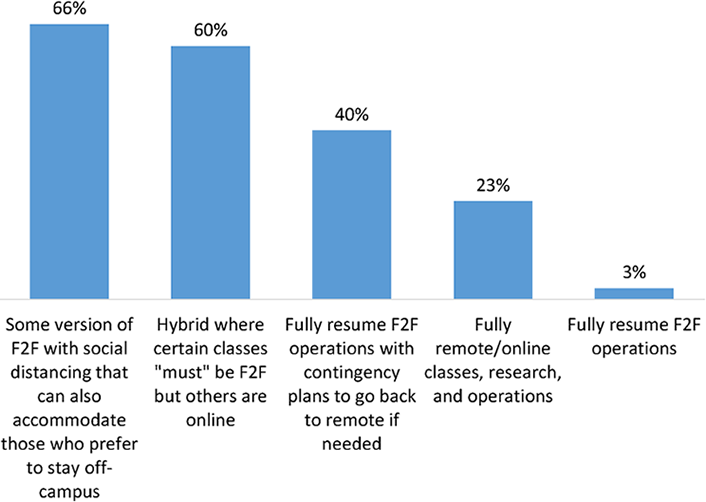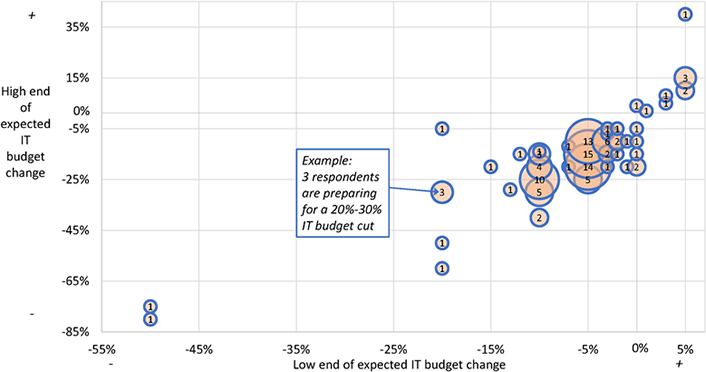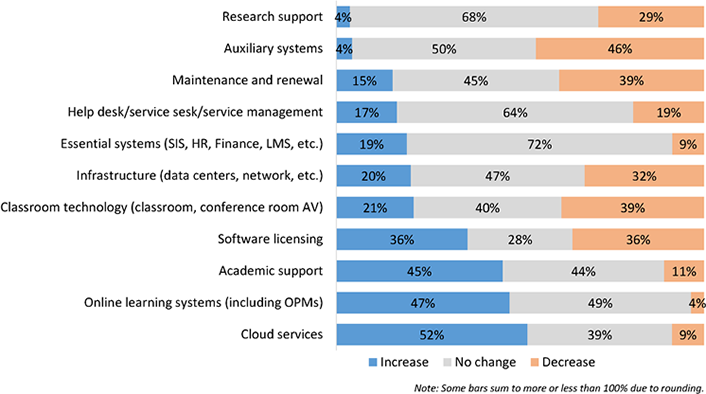Early data on some institutions' IT budget planning show that most (but not all) colleges and universities are preparing for cuts and that many options are under consideration.

As the COVID-19 pandemic upends higher education in 2020, institutions are relying on digital alternatives to missions, activities, and operations. Challenges abound. EDUCAUSE is helping institutional leaders, IT professionals, and other staff address their pressing challenges by sharing existing data and gathering new data from the higher education community. This report is based on an EDUCAUSE QuickPoll. QuickPolls enable us to rapidly gather, analyze, and share input from our community about specific emerging topics.1
The Challenge
In their responses to the pandemic this spring, higher education institutions relied heavily on information technology to fuel their pivot to fully remote education and work. With the frantic initial work well underway, institutions are now focused on the upcoming 2020–21 academic year. No one can predict how the pandemic will play out this fall and next year, and so institutions are planning in the context of great uncertainty. Although institutional IT organizations will continue to play a critical role during this next phase of the pandemic, the stop-gap methods used this past spring are no solution for the fall. New investments are needed, but most institutions are facing arguably the greatest financial crisis ever to hit higher education. This places great pressure on IT organizations to meet institutional expectations for cost reductions while preparing to deliver expanded digital services. What can we learn by taking an early peek at IT budget planning for the upcoming academic year?
The Bottom Line
As Leo Tolstoy wrote, "Happy families are all alike; every unhappy family is unhappy in its own way." These are not happy times for higher education, and our QuickPoll respondents suggest that institutions' choices about IT budgets and spending are highly variable.2 Respondents are preparing primarily for IT budget cuts between about 5% and 30%, but 24% of respondents anticipate no change or even an increase (of about 8%) in their budgets. Very few anticipate cutting budgets for cloud services, online learning, or academic support, which have supported so much of the remote work and education that is helping institutions continue during the pandemic. Most respondents reported that their institutions are considering numerous adjustments to IT budgets to reduce institutional costs. The most widespread changes seem to be instituting travel bans, delaying planned work, renegotiating contracts, implementing hiring and compensation-level freezes, reducing professional development, and investing in digital transformation.
Throughout the results are indications that the pandemic may widen an institutional digital divide in higher education, as some institutions may be persisting in viewing information technology as mere infrastructure while others are seizing the opportunity to accelerate their digital transformation efforts.
The Data: Institutional Context
Context matters. Institutional IT budgets need to reflect the institution's resources and priorities. The institutional planning underway for the fall is being strongly influenced by projected enrollments and potential scenarios for the impact of the COVID-19 pandemic.
Most respondents' institutions anticipate lower enrollments, but many could not provide an estimate. Four in ten of our respondents could not supply projections for their institutions' enrollments in fall 2020. Those who did provide an estimate overwhelmingly (86%) project a decrease, 12% projected an increase, and 2% estimated no change in enrollments. Half of the respondents projecting an increase were from community colleges. Respondents indicated that their institutions anticipate lower enrollments among international students (72% of respondents), residential students (68%), and commuter students taking campus-based courses (45%).
Fall scenarios are flexible. A bit more than half of respondents (57%) said their institutions are considering two or more possible scenarios for the fall. The most commonly reported scenario was pragmatically flexible: some version of face-to-face with social distancing that can also accommodate those who prefer to stay off-campus (66%). Only 3% of respondents indicated their institutions were considering full resumption of face-to-face operations with no contingency plans for remote. Almost one-quarter (23%) of respondents are planning for fully online classes, research, and operations; this of course includes some institutions that were already delivering fully online education before the pandemic (see figure 1).

IT priorities for the upcoming academic year seem aligned with institutional priorities. Almost. The survey asked respondents to rank-order seven potential priorities guiding budgeting planning for the upcoming academic year, once for the institution overall and once for the IT organization (see table 1).
Table 1. Priorities Guiding Budget Planning for the Upcoming Academic Year
|
Institutional budgeting priorities |
IT budgeting priorities |
|---|---|
|
1. Student and staff safety and health |
1. Student success |
|
2. Student success |
2. Reducing spending |
|
3. Reducing spending |
3. Student and staff safety and health |
|
4. Attaining enrollment targets |
4. Online teaching excellence |
The top three priorities guiding the institutional budget are also guiding the IT budget, although in different order. The fourth priority for each differs. Online teaching excellence is a fourth priority for IT budget planning, whereas attaining enrollment targets is fourth for respondents' institutional budgets. Two additional priorities not shown here were related to research (research continuity and retaining and attracting new research funds). Those priorities greatly lagged the others for both institutional and IT budget planning, even among doctoral and very large institutions.
The Data: Institutional IT Budget Planning
How does institutional leadership view the contribution of its IT organization? Every institution values information technology differently, and institutional leaders' expectations tend to encumber or enable the kinds of contributions that technology can make. Almost three in ten (29%) respondents felt their institutions' leadership viewed information technology as a driver of revenues, and half of respondents felt information technology was seen as a cost driver (see figure 2).

Most respondents are preparing for IT budget cuts. Almost three-quarters of respondents (72%) are preparing for cuts in the institutional IT budget for the upcoming academic year. One-quarter, however, are currently not preparing for any changes (16%) or are expecting an increase (8%). (The remaining 3% said they didn't know or hadn't yet prepared their budget.) Because times are so uncertain, we asked respondents to provide a range of budget changes they were anticipating. Four in ten respondents are preparing for cuts between 5% and 10–25%, and another 19% are preparing for cuts between 10% and 15–30% (see figure 3).

Respondents are planning to apply IT budget cuts strategically. The pandemic has demanded additional IT spending to move education and work online, and that will need to continue in the fall. Respondents' plans for their IT budgets are focused on a combination of cuts to reduce spending on less essential services (e.g., auxiliary systems and, at this time, classroom technology) and increases to support efficiencies (e.g., cloud services) and continued online operations (e.g., online learning systems) (see figure 4).
We found some differences in the planned changes based on institution type. Fewer community college respondents (17%) were planning to reduce spending on infrastructure. More private bachelor's respondents are planning no changes to their help desk (84%) or cloud services (58%) budgets. More public master's institutions are planning to increase cloud services (72%) and software licensing (56%) budgets, and more intend to decrease infrastructure budgets (53%). More respondents from private doctoral institutions anticipate lower budgets for auxiliary systems (67%), infrastructure (50%), and maintenance and renewal (68%), and more from public doctoral institutions expect to decrease help desk (38%) and software licensing (60%) budgets. Finally more respondents from the smallest institutions (fewer than 2,000 faculty, staff, and student FTEs) reported no planned changes to budgets for research support (89%), help desk (90%), and software licensing (52%).

Respondents reported that many adjustments are under consideration to reduce institutional IT costs. The survey listed fifteen potential IT spending adjustments and asked respondents which ones their institution was implementing or intending to implement, considering, or not considering to reduce institutional costs (see figure 5). Adjustments that would most likely be determined by state governments (for public institutions) or human resources departments had the highest proportion (over 10%) of "don't know" responses.
Several of the adjustments differ depending on Carnegie classification or institutional size. More respondents from the smallest institutions (fewer than 2,000 faculty, staff, and student FTEs) are not considering layoffs (67%) or retirement and other voluntary layoff incentives (64%), but more are considering benefit reductions (38%). More community college respondents reported they are not considering benefit reductions (53%), pay cuts (70%), furloughs (53%), service eliminations (57%), and renegotiating contracts and licensing (26%). More public master's institutions are implementing or intending to implement renegotiated contracts and licensing (81%) and retirement and other voluntary layoff incentives (42%). More public master's (86%) and public doctoral institution respondents (90%) reported not considering benefit reductions. More respondents from private doctoral institutions reported implementing or intending to implement pay cuts (35%) or benefit reductions (33%). More doctoral institution respondents indicated their institution was implementing or intending to implement hiring freezes (95% privates, 96% publics).

Promising Practices
Everything is on the table. Many adjustments are in play. Over three-quarters of respondents (77%) indicated that their institutions were considering, intending, or implementing eight or more of the fifteen adjustments, and 90% selected at least six. (These counts ignore respondents who said they didn't know whether an adjustment was being considered.) According to one respondent, "Everything is on the board. No options are NOT being considered."
Public institutions are facing a dual challenge. Several respondents from public institutions commented that they were already facing budget reductions from their states. One respondent explained, "The items marked as 'implementing' we already had in place due to other state-wide issues occurring, so it puts us ahead a bit, but we are going deeper in reductions due to the pandemic."
Many institutions are laying the groundwork for permanent change. As one respondent wrote, "We are thinking this is a 'permanent' exercise (i.e., at least a few years), considering the upcoming recession and uncertainty of the length of the new normal of life." Another explained, "The doors are wide open for change and transformation. We are bending the metal while it's hot."
Digital transformation is a way to bend the metal, and over 90% of respondents indicated that their institutions are implementing or intending to implement (47%) or are considering (45%) digital transformation as a way of reducing institutional costs. Respondents described both tactical and ambitious objectives:
- "We are reviewing increasing the digital fluency of the students."
- "We need to move ahead of others and expand our provision and global reach."
- "We plan to reduce or eliminate low-priority services to create budget capacity for investments in digital transformation."
But some respondents reported that their institutions still view information technology as a cost, not a revenue driver, and are not including IT leaders in strategic conversations:
- "Right now there is significant concern across the executive level about what lies ahead. In the Maslow hierarchy of needs, we have dropped from self-actualization back to base levels. IT has been relegated back to being the plumbing. It would be tone-deaf to be trying to move this forward even though being digital is saving us. Teaching and learning and other academic leaders are in the forefront, and we are relying on them to bring us to the table."
- "I'm not part of some of these cabinet discussions and am afraid IT decisions are being made by those who know the least. I'm being told to not fill a position while being asked to do more."
Everything is unsettled, and no one can predict what the fall will bring. Higher education institutions are preparing for grim times. The choices that leaders make will shape their institutions and higher education for many years, perhaps permanently. Our early indicators of potential changes to institutional IT budgets suggest that while some institutions intend to use the pandemic to vault ahead and accelerate transformation, others may have a reactive approach that reverts to old choices and diminishes the value of information technology at a time when it could do so much.
EDUCAUSE will continue to monitor higher education and technology related issues during the course of the COVID-19 pandemic. For additional resources, please visit the EDUCAUSE COVID-19 web page. All QuickPoll results can be found on the EDUCAUSE QuickPolls web page.
For more information and analysis about higher education IT research and data, please visit the EDUCAUSE Review Data Bytes blog as well as the EDUCAUSE Center for Analysis and Research.
Notes
- QuickPolls are less formal than EDUCAUSE survey research. They gather data in a single day instead of over several weeks, are distributed by EDUCAUSE staff to relevant EDUCAUSE Community Groups rather than via our enterprise survey infrastructure, and do not enable us to associate responses with specific institutions. ↩
- The poll was conducted between April 28 and May 1, 2020. Respondents represented 155 institutions. The poll consisted of 14 questions and took respondents a median time of 7 minutes and 18 seconds to complete. Poll invitations were sent to participants in five EDUCAUSE community groups (CIO, Community Colleges, State Systems, Small Colleges, and Arts and Design). Most respondents (147) represented US institutions. Respondents from Canada and the United Kingdom also participated. An appropriately diverse and well-balanced range of institution sizes and Carnegie classifications participated. ↩
Susan Grajek is Vice President of Communities and Research at EDUCAUSE.
© 2020 Susan Grajek. The text of this work is licensed under a Creative Commons BY-NC-ND 4.0 International License.
